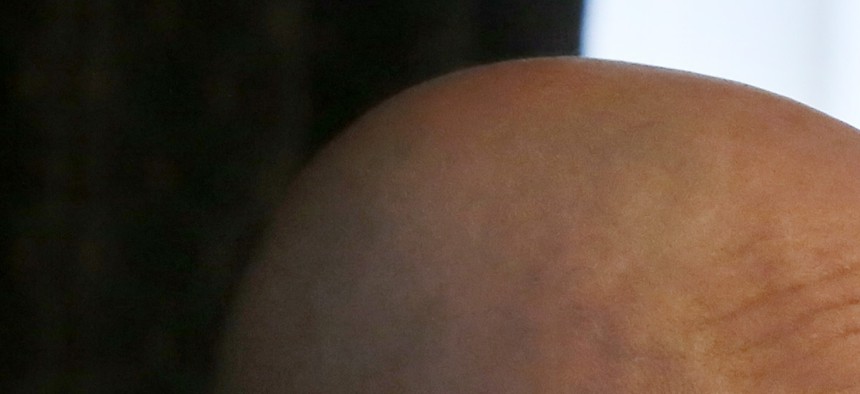Amid Ongoing Federal Scrutiny, Pittsburgh’s New Police Chief Works to Ease Local Tensions

New Pittsburgh Police Chief Cameron McLay, left, answers questions during a news conference after being introduced by Pittsburgh Mayor Bill Peduto, right, on Friday, Sept. 12, 2014. Keith Srakocic / AP Photo
Cameron McLay: “The reality of U.S. policing is that our enforcement efforts have a disparate impact on communities of color.”
Less than a month after being sworn in as Pittsburgh’s permanent top cop, Chief Cameron McLay has been getting early praise for how he’s been handling a tense period in police-community relations in Pennsylvania’s second-largest city.
In December, amid an ongoing federal investigation into a 2012 incident where a white police officer shot and paralyzed a black motorist, McLay announced that the officer involved in the shooting had been assigned to desk duty until the U.S. Department of Justice concluded its examination of the shooting, which has raised tensions in Pittsburgh’s minority communities.
The Pittsburgh Post-Gazette’s editorial board recently wrote that McLay, brought on as interim chief in September by Mayor Bill Peduto and confirmed by the City Council in December, “has done something important. He showed that he is listening.”
In addition to listening, the new chief—brought in amid a messy period for Pittsburgh’s Bureau of Police, including a corruption scandal that saw former chief Nathan Harper indicted and convicted and ongoing federal oversight because of a “pattern and practice” of police misconduct—has been busy writing.
In an open letter published on Dec. 24 announcing the decision to assign the officer involved in the shooting to desk duty, McLay detailed his thoughts about the current state of police-community relations and the need “demonstrate to our communities of color that we hear and understand the pain.”
The chief noted that in Pittsburgh, “public trust is in jeopardy. If we, the police, are to regain legitimacy, we must assure those calling for change that we hear and understand them, and are committed to police accountability.”
McLay expanded his thoughts in commentary posted to the Bureau of Police’s Facebook page on Friday:
The reality of US policing is that our enforcement efforts have a disparate impact on communities of color. This is a statistical fact. You know, as well as I, the social factors driving this reality. The gross disparity in wealth and opportunity is evident in our city. Frustration and disorder are certain to follow. The predominant patterns of our city's increased violence involves black victims as well as actors. If we are to address this violence, we must work together with our communities of color.
We, the Pittsburgh Bureau of Police, need to acknowledge how this reality feels to those impacted communities. Crime and disorder take us to the disadvantaged communities, which are predominantly those of color. The disparities in police arrest and incarceration rates that follow are not by design, but they can feel that way to some people in those communities.
The full text of what McLay wrote follows:
From the desk of Chief McLay - I was recently asked: "Chief: Why are you talking to and supporting groups complaining about racial injustice?"
The question is often asked about the appropriate balance between police and community concerns in municipal policing. It is the job of the Chief of Police to reduce crime, fear and disorder for all of the communities served.
It is my job as your Chief, to protect the Bureau from unreasonable political interference. I am committed to that role. It is also my role to ensure we are responsive to community needs. Simply put: I am the Chief of Police for the City of Pittsburgh and all of its citizens.
The reality of US policing is that our enforcement efforts have a disparate impact on communities of color. This is a statistical fact. You know, as well as I, the social factors driving this reality. The gross disparity in wealth and opportunity is evident in our city. Frustration and disorder are certain to follow. The predominant patterns of our city's increased violence involves black victims as well as actors. If we are to address this violence, we must work together with our communities of color.
We, the Pittsburgh Bureau of Police, need to acknowledge how this reality feels to those impacted communities. Crime and disorder take us to the disadvantaged communities, which are predominantly those of color. The disparities in police arrest and incarceration rates that follow are not by design, but they can feel that way to some people in those communities.
I know, because I have been there too. My own street drug enforcement efforts were well intended but had an impact I would not have consciously chosen. In retrospect, we should have been far more engaged with those in the communities where we were doing our high-impact, zero tolerance type policing; to obtain the consent of those we were policing.
We will be engaging in training to refine our policing efforts in the near future. In the mean time, we will simply approach our job mindfully, with a continued motivation to protect and serve.
Please beware also, race impacts how we view one another, and unconscious bias applies to how we deal with the public. It can also impact how we judge one another; I intend we will confront both through training.
I support efforts to keep our communities safe, and will back the best efforts to do so. I trust and have faith in you. I also support efforts to improve and restore the communities' perceptions of justice. The next time you see me engaging in discussions supporting social justice, please remember, we are all guardians of the constitution. This is the mission we all took an oath to uphold.
Thank you for joining me in restoring the legitimacy of the policing profession.
NEXT STORY: 2014's Dumbest Local Ordinances






